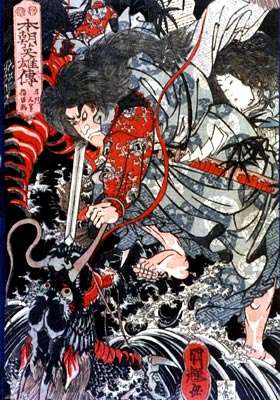Izanagi
 Searching the Seas with the Tenkei (天瓊を以て滄海を探るの図 Tenkei o motte sōkai o saguru no zu). Painting by Kobayashi Eitaku, 1880-90 (MFA, Boston). Izanagi with spear Amenonuhoko to the right, Izanami to the left. |
Izanagi (イザナギ, recorded in the Kojiki as 伊邪那岐 and in the Nihon Shoki as 伊弉諾) is a deity born of the seven divine generations in Japanese mythology and Shinto, and his name in the Kojiki is roughly translated to as "he-who-invites" or Izanagi-no-mikoto. He is also known as Izanagi-no-Okami.
Accounts in mythology
Izanagi and Izanami
He with his spouse and younger sister Izanami gave birth to the many islands of Japan (kuniumi), and begat numerous deities of Shintoism (kamiumi). But she died after giving birth to the fire-god Kagu-tsuchi. Izanagi executed the fire god with the "ten-grasp sword" (Totsuka-no-Tsurugi). Afterwards, he paid his wife a visit in Yomi-no-kuni (the Underworld) in the hopes of retrieving her. But she had partaken of food cooked in the furnace of the Underworld, rendering her return impossible. Izanagi betrayed his promise not to look at her, and lit up a fire, only to behold her in her monstrous and hellish state. To avenge her shame, she dispatched the lightning god Yakusa no ikazuchi no kami (Raijin) and the horrible hag Yomotsu-shikome to chase after him. Izanagi escaped, but the goddess declared to kill a thousand of his people every day. Izanagi retorted that a thousand and five hundred will be born every day.[1][2][3]
Cleansing and birth of Amaterasu, Tsukuyomi, and Susanoo
In the cleansing rite after his return, he begot Amaterasu (the sun goddess) from his left eye, Tsukuyomi (the moon god) from his right eye and Susanoo (tempest or storm god) from his nose.[4]
Parallels
Izanagi's visit to his wife Izanami in Yomi-no-kuni somewhat parallels the Greek Orpheus's visit to Eurydice in the underworld,[5] but a more striking resemblance is his wife's inability to return after eating the food in hell, matched by Persephone of Greek myth.[6]
In popular culture
- Izanagi Boom, a period of high economic growth in Japan in the second half of the 1960s.
- The name of this deity appears incorrectly spelled as "Izagi" in Puccini's opera Madama Butterfly.
- Izanagi, Izanami, Amaterasu, Tsukuyomi and Susanoo are various eye techniques of the Uchiha clan in the Japanese manga Naruto. Izanagi being a technique that can undo a path, in exchange of an eye. Izanami traps a target in an infinite loop,in exchange of an eye. Amaterasu is an inextinguishable flame technique. Tsukuyomi is an illusionary technique and Susanoo is an armored entity that acts as the eye holder's armor.
- Izanagi is also the name of a character in the anime Mai-HiME.
- Izanagi is a Monster Card in the popular Trading Card Game, Yugioh.
- In the anime Darker than BLACK season 2, Izanagi is referenced multiple times and "will meet with Izanami to reshape the world."
- Izanagi, Izanami, Amaterasu, Tsukuyomi and Susanoo appear as characters in the video game Ōkami.
- Izanagi is also manifested as a persona for the protagonist in the popular Japanese role playing game, Shin Megami Tensei: Persona 4.
- Izanagi, Izanami, Amaterasu, Tsukuyomi and Susanoo appear as characters in the video game Puzzle and Dragons.
- In Nurarihyon no Mago: Sennen Makyou, "Kanzen naru fusei, Izanagi" is a technique used by Awashima, a Yōkai whose name was taken from Izanami and Izanagi's second child.
- Izanagi is a name of a corporation appearing in the Unreal series.
See also
References
- ↑ Phillipi, Donald L. (1969). Kojiki. Tokyo: University of Tokyo Press. p. 66.
- ↑ Chamberlain, Sir Basil Hall (1882). "A Translation of the 'Ko-ji-ki', or Records of Ancient Matters". Transactions of the Asiatic Society of Japan. VI, Section IX. Yokohama. p. 86.; Reedited in Horne, Charles Francis, ed. (1917). The Sacred Books and Early Literature of the East: With an Historical Survey and Descriptions. 13. Parke. pp. 8–61. Wikisource:
 ""2.1 The Land of Hades".
""2.1 The Land of Hades". - ↑ Aston, William George (1896). Nihongi: Chronicles of Japan from the Earliest Times to A.D. 697. 1. London: Japan Society of London. pp. 24–.
- ↑ Melvyn Bragg (22 Sep 2011). "In Our Time". www.bbc.co.uk (Podcast). British Broadcasting Corporation. Event occurs at 17:14. Retrieved 29 April 2012.
- ↑ Sweet, Charles Filkins (1919). New life in the oldest empire. Macmillan. pp. 1–7.
- ↑ Sansom, George Bailey (1919). A History of Japan: To 1334. Macmillan. p. 30.

